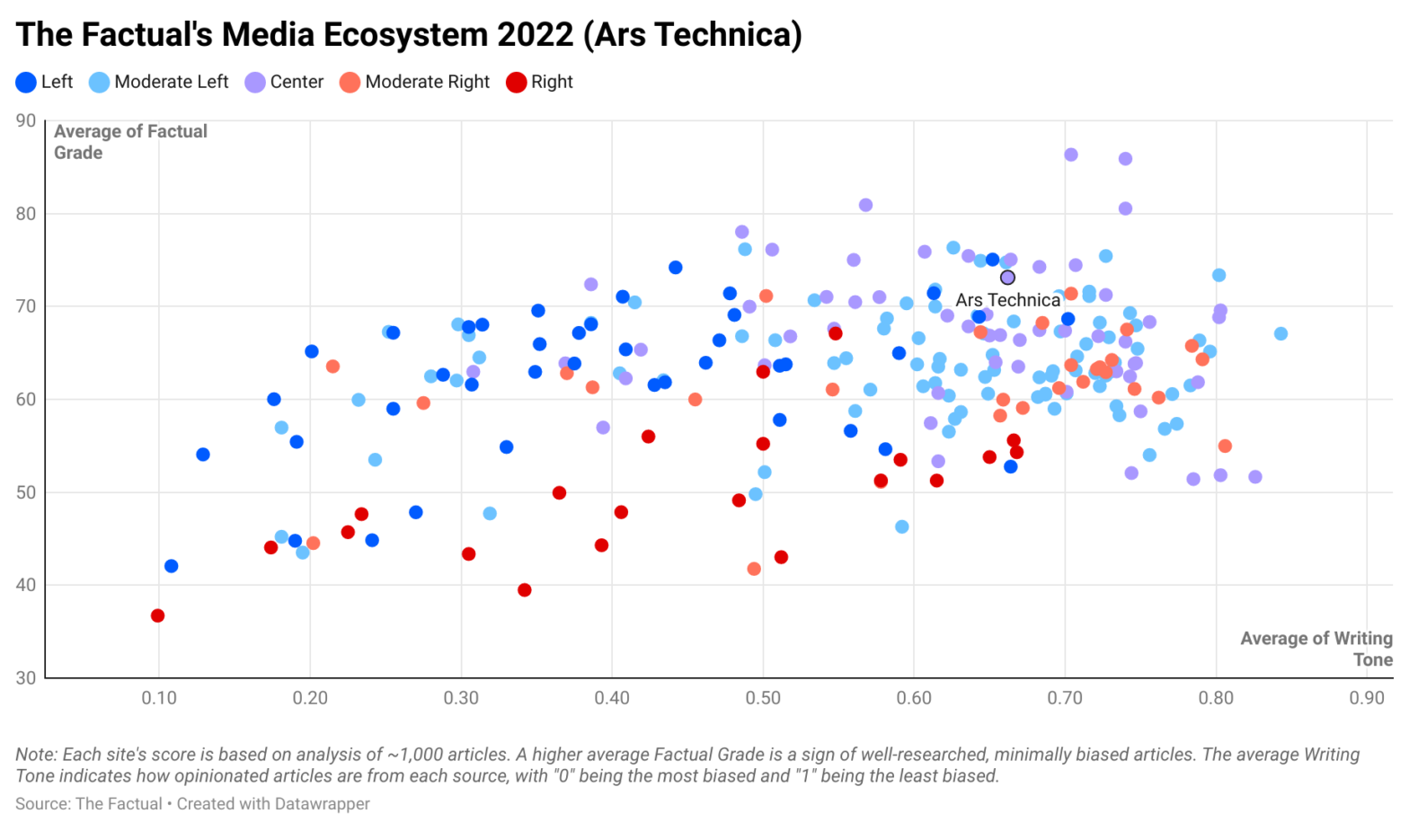Ars Technica — meaning “art of technology” — is the fitting name of a publication aimed at technology enthusiasts. A leading source for technology news, including technology policy, product launches, and the latest hardware and software, Ars Technica caters to a core readership, which they define as “Readers [who] have come to demand devotedness to accuracy and integrity, flanked by a willingness to leave each day’s meaningless, click-bait fodder by the wayside.” Given Ars Technica’s dedication to “accuracy and integrity,” The Factual asks: how factual are its articles and how biased is its content?
How Does The Factual Rate News Sources?
The Factual analyzes more than 10,000 news stories every day to help readers find the most informative, least-biased articles. Our news-rating algorithm scores each article along four metrics: (1) cited sources and quotes, (2) publication history, (3) writing tone, and (4) author expertise. These scores combine in a weighted average we call a Factual Grade, which ranges from 0–100%. (See our How It Works page to learn more about our algorithm.)
For this study, we analyzed ~1,000 articles each from 240 news sources. The average Factual Grade for the entire dataset was 62.5%. Based on these averages, we can compare the performance of news sites across the media ecosystem. The entire dataset can be explored in greater detail here.
How Factual Is Ars Technica?
Ars Technica scored an average Factual Grade of 73.1%, placing it in the top 25 sources of the 240 that we analyzed. These high scores can be attributed to the site’s dedication to accuracy and extensive research, reflected through the extensive sourcing of information. Likewise, the site employs dedicated, experienced journalists to cover specific beats, leading to higher overall author expertise scores.
Like any news source, scores for articles from Ars Technica varied widely. For example, some scored above 90%, while others scored below 60%.
Please check your email for instructions to ensure that the newsletter arrives in your inbox tomorrow.
How Opinionated is Ars Technica?
One of the metrics The Factual uses is the Writing Tone, which measures how opinionated the writing is in an article. For this metric, the algorithm looks for signs of subjective commentary (e.g., first person pronouns and unnecessary adverbs), as well as the emotional nature of selected words, and sees how prevalent they are for a given length of text. More neutral text receives higher ratings, with “0” being the most opinionated and “1” being the most neutral.
Ars Technica had an average score of 0.66, placing it in the 63rd percentile in our dataset. Overall, this suggests that articles from Ars Technica tend to lean toward a neutral writing tone but still may exhibit some bias. This can be seen through neutral headlines such as “VW sells out of electric cars in US and Europe” and more biased headlines such as “Americans want to be carbon neutral, don’t want to take needed steps.”
What is Ars Technica’s Political Bias?
The Factual classifies news sites by political bias as either Left, Moderate Left, Center, Moderate Right, or Right. The Factual derives this classification from third-party assessments from media bias organizations such as AllSides and Media Bias/Fact Check (MBFC). Based on this data, The Factual assigns Ars Technica a Center political bias.
MBFC ranks Ars Technica as “Least Biased,” their term for the center of the political spectrum. This score is due to minimal bias in story selection and limited use of loaded words in reporting. Moreover, MBFC notes that Ars Technica sticks to a topic area and has never failed a fact check. Brietbart has accused Ars Technica of having a liberal bias, but MBFC’s review could find no evidence of an overt left or right political bias.
AllSides has yet to complete a full review of Ars Technica but assigns the site a "Center" bias.
Who Owns Ars Technica?
Acquired in 2008 by Advance, the parent company of Condé Nast, Ars Technica has offices in Boston, New York, Chicago, and San Francisco. Today, Ars Technica operates as Condé Nast’s only 100% digitally native editorial publication.
Condé Nast owns a number of other publications, including the New Yorker, Wired, Vogue, and Vanity Fair, all of which The Factual scores as having a Left or Moderate Left bias. However, there is no evidence that Condé Nast’s ownership influences the journalistic output of these publications or Ars Technica.
Please check your email for instructions to ensure that the newsletter arrives in your inbox tomorrow.
Why Does it Matter?
News articles are bound to have bias because all authors have some frame of reference within which they describe a story. Political bias ratings are helpful in understanding this framing. However, it can be more beneficial to know how factual an article is based on quantifiable metrics that can be seen across the media ecosystem, from cited evidence, to author expertise, to the writing tone. This is what The Factual ascertains.
Reading several, highly rated articles from across the political spectrum helps counter the bias of any news source or story. To have the day’s most factual news stories delivered to your inbox every morning, subscribe to our daily newsletter.
This article was updated on September 15, 2022 to reflect new data.

